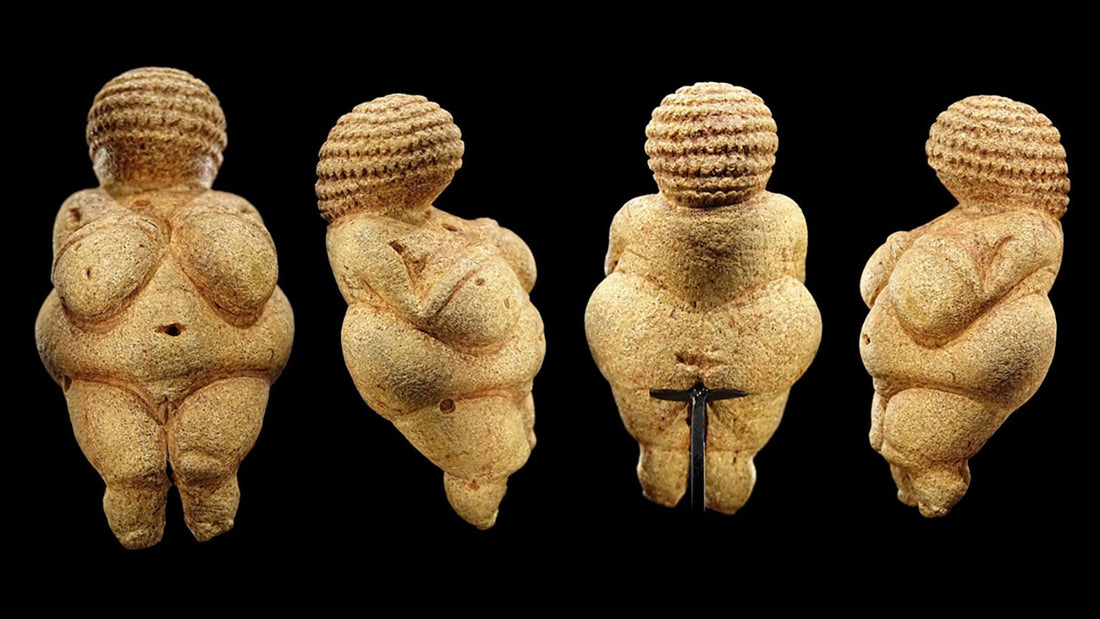Feature image: Venus figurines via Natural History Museum Vienna
Are They Really Venus?
50,000 to 10,000 years ago, ancient inhabitants of Europe created small statuettes that depicted the female form. Hundreds of these small figurines have been unearthed from the south of France to Siberia. They are the earliest examples of art that depicts the human image, the oldest of which dates to over 35,000 years old. The figurines are small enough to fit in the palm of one's hand and were made from stone, bone, ivory, het, hematite limonite, horse teeth, and fired loess. They are often faceless and feature large hips, breasts, and exaggerated sex organs.

Modern society was introduced to these statuettes during the 1890s.. Scholars at the time, who were mostly male, saw the exaggerated female anatomy of these figurines and interpreted them as symbols of fertility and sex. For decades these statues were believed to be made by men for men. This belief was further ingrained by scholars giving these statuettes the name Venus to group them with portrayals of the Roman goddess of love, beauty, fertility, sex, and desire. Examples of this include the Venus of Willendorf, Venus of Dolni Vestonice, Venus of Lespugue, Venus of Brassempouy, Venus of Laussel, Venus of Hohle Fels, Venus of Galgenberg, Venus of Moravany, and the Venus of Monruz. While this interpretation was not necessarily offered with malicious intent, it has left a damaging effect by reducing these figurines and the complex ancient societies from which they came to just another example of a primitive expression of contemporary gender norms. Until the rise of feminism and feminist scholarship in the 1960s-70s, this interpretation was never called into question. Since then, new interpretations of the purpose and meaning of these statuettes have been offered.

In 1996, scholars Catherine McCoid and Leroy McDermott hypothesized that the Venus figurines were actually a form of self-representation. They reject the role of a woman as a passive object, one meant just to be viewed, in favor of a woman as an active participant, her own subject. When viewing the figurines from the front or back, the proportions of these women appear exaggerated, but a top-down perspective reveals a novel dimension. Mirrors did not exist during this time; the only way for a woman to view herself would be by looking down at her own body. McCoid and McDermott argue that this interpretation also explains why so many of these statuettes have small or missing heads.

Researchers have also explored the idea that these figures were created as a symbol of survival in response to freezing conditions. Statuettes found in close proximity to ancient glaciers seemed to be more voluptuous. (These figures were created during the last Ice Age.) In such frigid conditions, more body fat would have been not only desirable but also more conducive for survival. Some scholars contend that these figures may have acted as personal charms meant to help their female owners achieve greater body fat, particularly among pregnant women. Some believe that these figures themselves are pregnant, which would make the statuettes among the earliest depictions of pregnant women. Under this belief, scholars have wondered if these figurines were meant to ward off difficulties in childbirth or, alternatively, were an expression of a man’s desire for a woman who would bear him children. These interpretations are disputed, with opponents maintaining that the hunter-gatherer societies these statuettes were created in likely strove to control the frequency of childbirth. Abundant fertility did not mesh well with the frequent movement of these people, nor was it advantageous for their systems of food management, water, and shelter.


Other common interpretations propound that these figurines were created to serve a religious purpose, were dolls for children, representations of witches, or figurines meant to keep strangers away. Ultimately, scholars cannot conclusively assign meaning to these ancient, feminine statuettes. We do know, however, that attempting to interpret their meanings exclusively through modern understandings of society and gender only leads to reductionist ideas. We have no way of fully knowing how prehistoric cultures understood gender, nudity, or sex, and as such, scholars should do all they can to avoid narrowly interpreting these works through modern views on these topics. In an attempt to rectify the long-standing misinterpretation of these figurines, many scholars have now replaced the word Venus with woman.
©ArtRKL™️ LLC 2021-2024. All rights reserved. This material may not be published, broadcast, rewritten or redistributed. ArtRKL™️ and its underscore design indicate trademarks of ArtRKL™️ LLC and its subsidiaries.





